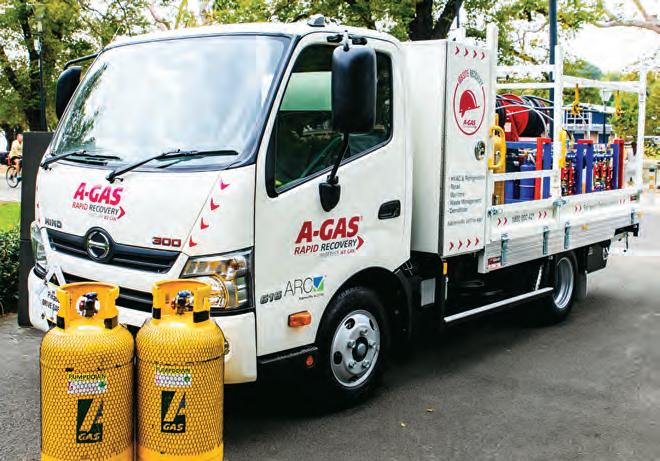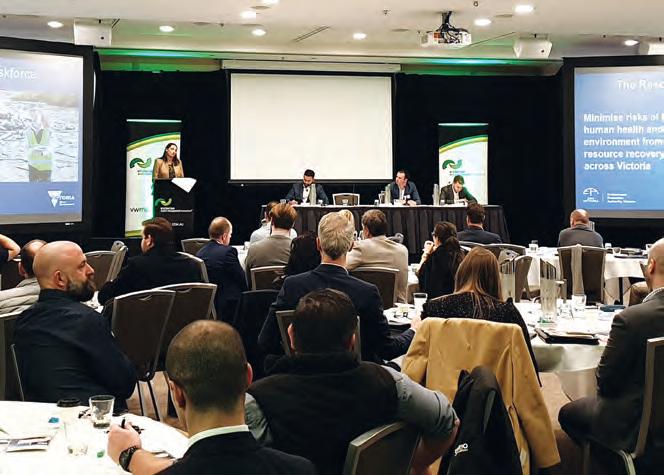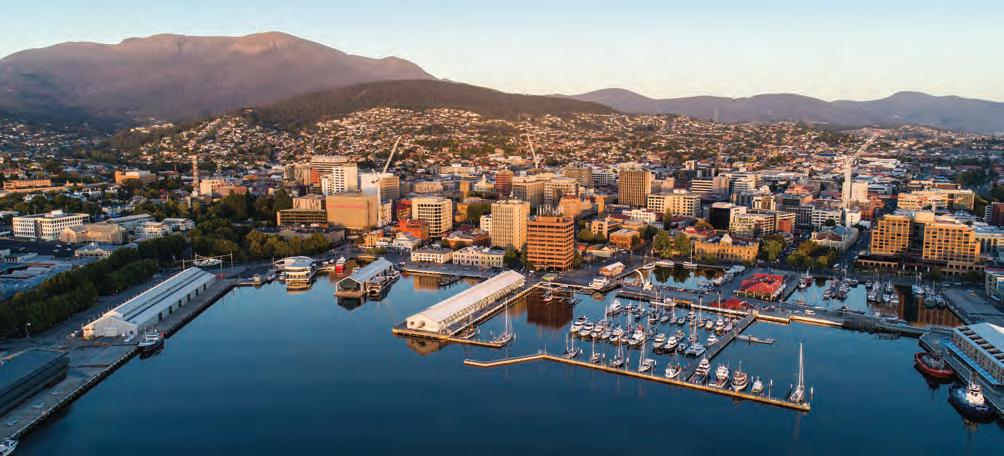
13 minute read
GROWING THE ISLAND STATE
WASTE MANAGEMENT REVIEW EXPLORES TASMANIA’S NEW DRAFT WASTE ACTION PLAN AND INDUSTRY GROWTH OUTSIDE THE MAINLAND.
Tasmanian resource recovery has traditionally fallen behind other states and territories, with a 2018 rate of 50 per cent. The state is home to a large industrial sector, and as such, it produces more waste than its population would suggest.
Tasmania’s island geography creates further challenges, with the cost of transporting waste to the mainland for recovery making the process often unviable.
The state’s new draft Waste Action Plan, released 29 June, has provided a framework of identifiable actions to tackle these issues and grow Tasmania’s waste and resource recovery sector.
According to former Environment Minister Elise Archer, who held the portfolio when the plan was drafted,
the government’s commitment to a statewide waste levy and container deposit scheme (CDS) are the action plan’s cornerstones.
Waste Management Review spoke with the state Department of Primary Industries, Parks, Water and Environment in August.
According to a spokesperson for the department, the state government, waste industry, local business and broader community are all responsible for managing the waste Tasmania produces.
“Our government understands it has an important role to play to help people make informed choices and support innovative waste and recycling initiatives,” the spokesperson says.
“In response to some of Tasmania’s
Tasmania is taking action on resource recovery with a waste levy and other plans.
most pressing waste issues, government has already acted through investing in controlled waste and tyre processing facilities and assisting the roll-out of national product stewardship schemes for e-waste, paint, tyres, batteries and packaging.”
As new challenges and opportunities arise, Tasmania has recognised the need to take action. Core issues include finding ways to divert organic waste from landfill to reduce emissions, and helping councils and businesses adapt to recent restrictions on the importing of recyclable materials.
“Shipping recyclables or recovered resources from Tasmania to end markets is a cost, and due to Tasmania’s population size and distance from markets, it can be challenging to find
a critical mass of some waste-based resources, and to improve the purity and quality, and hence value, of materials,” the spokesperson says.
“As the solutions to our waste and recycling challenges are strongly market-based, capacity should be developed to support the establishment of recycling and reuse businesses, which would include support for domestic businesses entering national and international markets.”
Through targeted engagement with industry and other relevant stakeholders, the department has identified a number of waste management priorities for the state, in line with the National Waste Policy.
“The changing policy environment, in addition to challenging markets for recyclable materials, highlighted Tasmania’s need to develop its own strategic and integrated approach to waste management,” she says.
LANDFILL LEVY The action plan’s introduction of a waste levy is particularly notable, given the state’s past reluctance.
“The absence of a landfill levy, along with other challenges, means waste businesses in Tasmania have struggled, particularly in times of market disruption,” the spokesperson says.
“We propose that the levy will be developed in consultation with all stakeholders and take into account the potential impacts for households and businesses.”
Gayle Sloan, Waste Management and Resource Recovery Association of Australia CEO, says she is pleased Tasmania has finally proposed a waste and resource recovery strategy.
“In releasing the plan, the state has acknowledged that waste management is a shared responsibility between all levels of government, the private sector and community,” she says.
“The state government should be congratulated for listening to industry about the importance of a levy as an economic tool for prioritising resource recovery, as well as working with industry and the community to design and set the levy.”
The spokesperson says government will also develop legislation to indicate how collected revenue will be allocated, while ensuring regional authorities, who’s existing levies will be replaced, continue to derive a revenue stream.
Currently, multiple state councils and collaborative bodies, such as the Northern Tasmanian Waste Management Group, have a locally administered voluntary levy of $5 per tonne.
Christina Holmdahl, Local Government Association of Tasmania President, says the local government waste generators, while additionally creating an income stream to reinvest in business growth, resource recovery infrastructure and other programs, such as initiatives or grants to promote landfill alternatives.
Pete Shmigel, Australian Council of Recycling CEO, says the levy, and policy at large, illustrates smart and progressive reform. He adds that government needs to set the new levy at a sufficient level to drive positive results and industry investment.
“This new plan can start turning the Apple Isle from a recycling laggard to a recycling leader, and that’s something our industry and no doubt the people of Tasmania support,” Pete says.
Pete also notes the introduction of a CDS is a positive step towards reducing litter and improving recyclate quality.
Spokesperson Tasmanian Department of Primary Industries, Parks, Water and Environment
sector had been calling for action and leadership on waste and recycling for a long time.
““Our sector is pleased the state government is implementing a statewide waste levy and has announced a draft Waste Action Plan,” Christina says.
“It is important that resources are directed to supporting industry, councils and the community to develop markets for recycled product and improving resource recovery.”
According to the action plan, the levy will provide a pricing signal to
CONTAINER DEPOSIT SCHEME When Tasmania announced it would implement a CDS in early June, it became the seventh state or territory to develop a scheme, leaving just Victoria behind.
According to the spokesperson, drink containers account for an estimated 41 per cent of litter volume in the state.
“Implementation in other Australian jurisdictions, and international case studies, show CDS’s are one of the most effective mechanisms to change littering behaviour and produce purer streams of
recyclable material,” she explains.
Despite announcing the scheme in June, the state has yet to introduce legislation to parliament. The spokesperson says full scheme implementation is expected by 2022.
According to the draft action plan, the time required to implement the scheme is based on advice from other jurisdictions and wider government research.
“This will provide time to establish the required contracts for markets that will receive the collected recyclable material,” the Department of Primary Industries, Parks, Water and Environment spokesperson says.
As outlined in the action plan, Tasmania hopes to achieve the lowest incidence of littering in the country by 2023. This is particularly important for a state that derives significant capital from its natural environment tourist economy.
“Government is establishing a Litter and Dumping Management System, which includes an online application to improve reporting of littering and dumping, and a system for land managers to identify and address dumping or littering hotspots,” she says.
“The Tasmanian Litter Act 2007 is also being amended to increase the penalties and fines for people convicted of illegal dumping.”
The spokesperson says the Keep Australia Beautiful Litter Index will be used as a measurement baseline.
PRIORITY AREAS Other strategy targets include ensuring 100 per cent of packaging is reusable, recyclable or compostable by 2025, reducing waste generation by 10 per cent per person by 2030 and achieving an 80 per cent average recovery rate from all waste streams by 2030.
“All of the key areas and priority actions in the action plan will contribute to these goals,” she explains.
The action plan identifies seven priority focus areas: moving towards a circular economy, governance, data targets and innovation networks, infrastructure planning, support for the resource recovery industry, education and community engagement and state and national policy and regulatory settings.
The spokesperson highlights accurate reporting and subsequent market improvement as critical to creating an interconnected supply chain and achieving targets.
According to the action plan, integration will lead to formerly separate sectors, such as food and agriculture, forming larger industries to stimulate the bio-economy.
“Finding innovative approaches to preventing or reusing organic waste arises naturally out of the bio-economy, which seeks to maximise value chains for products and services,” she says.
“These innovation networks provide research and development and technology transfer opportunities, for example in fit-forpurpose technologies that address specific regional needs while bringing global investment to the state.
Container Deposit Scheme legislation implementation is expected by 2022.

The spokesperson says achieving the plans ambitious goals will require significant planning and investment in waste and resource recovery infrastructure.
“Tasmania is likely to have similar investment priorities to those identified through infrastructure planning processes in other Australian states.”
“These include kerbside source separation bins, particularly for organic waste, processing facilities for organics, drop-off facilities for various recyclable materials, specialised facilities for commercial and industrial waste, construction and demolition waste and energy-from-waste infrastructure.”
The spokesperson adds that this will require greater understanding of existing capacity and waste trends.
“Increasing recovery rates is not possible without supporting new and existing waste and recycling businesses.
“This needs to work at the level of individual business, while also providing broader strategic approaches to developing markets in Tasmania, to help improve access to mainland and international markets.”
A Waste and Resource Recovery Infrastructure Plan will be established by 2021.


Lifting laneway recovery
THE CITY OF MELBOURNE TALKS TO WASTE MANAGEMENT REVIEW ABOUT THE CITY’S DRAFT WASTE AND RESOURCE RECOVERY STRATEGY AND RECYCLING INITIATIVES IN THE CBD.
Q. What were some of the key factors influencing the development of the City of Melbourne’s Draft Waste and Resource Recovery Strategy 2030? A. The circular economy concept underpins our Waste and Resource Recovery Strategy 2030 (WRRS), which was endorsed by council 16 July 2019.
The strategy outlines an ambitious plan to transition to a 90 per cent waste from landfill diversion rate, reduce truck movements, improve public amenity and reinvigorate our recycling sector.
Q. What are the key ingredients that go into making an organics trial a success? A. With food making up 50 per cent of household waste in our municipality, finding a solution for discarded food scraps is a key component of the WRRS.
Our residents discarded an estimated 12,000 tonnes of food waste in 2016–17, and through our engagement with the community, we know people want a solution to avoid food going to landfill.
Later in the year we will look at a food and organic waste collection trial, to determine how collection services could work for residents with kerbside bins.
A third bin for organic waste would be rolled out and collected weekly, building on an earlier trial in 2017.
The trial will help us design an effective waste collection service for the whole municipality in the future.
Q. How has the Degraves Street Recycling Facility helped boost food diversion for businesses? A. The Degraves Facility is a boutique response to the high-density café demographic, and is strategically located due to the high volume of businesses in the area.
By creating a local recycling hub, the City of Melbourne has boosted amenity by limiting the amount of rubbish bins on the street and reducing truck movements.
In 2013, none of the 100 businesses surrounding Degraves Street were recycling. The facility now hosts a food waste processor, a cardboard baler and co-mingled recycling bins.
Each week, 2.5 tonnes of organic waste is processed by the Orca and diverted from landfill.
The Orca uses aerobic digestion to break down the food waste, turning it into water that then goes safely into the sewer.
The City of Melbourne would like to see more recycled product in infrastructure.
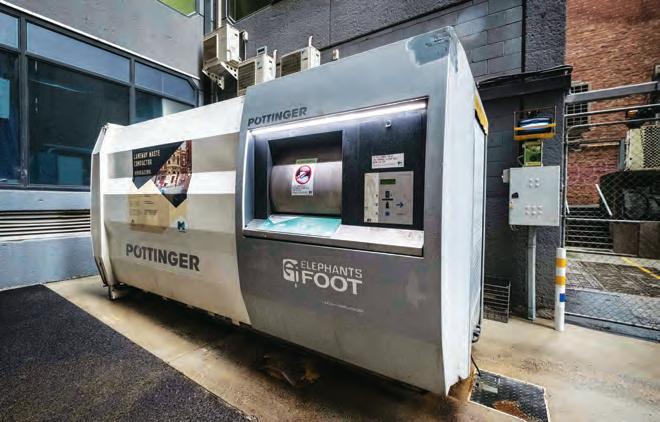
Q. How is the City of Melbourne addressing challenges such as population growth, high density collection, greenhouse gas emissions and climate change? A. Ensuring Melbourne maintains its status of one of the world’s most liveable cities – as the daily population grows from 911,000 to 1.4 million by 2036 – is one of our biggest challenges and is therefore
central to all our strategic plans.
The WRRS seeks to streamline the waste system and reduce congestion on roads and footpaths, where some of our bins are stored.
To action this, we will introduce more shared waste hubs for businesses in the central city, and remove some commercial bins from the public realm.
We also want to expand the network of five communal waste compactors and recycling hubs in central city laneways, which currently take waste from more than 300 businesses. We can dramatically reduce the number of bins lining our laneways and the number of trucks on our streets by creating more central waste drop-off points.
Reducing the impact of waste is central to the city’s commitment to taking action on climate change, and will help us reach the key target of avoiding 1.2 million tonnes of greenhouse gas emissions by 2030. THIS YAWEI LASER IS DESIGNED TO CUT ABOVE THE REST. NOW THAT’S APPLIED THINKING. Polystar unwraps the value in film recycling. Now that’s Applied Thinking. R E D U C E S W A S T E S I M P L E T O U S E
Q. What are the challenges and opportunities to boost City of Melbourne’s 25 per cent recycling rate? A. Household waste makes up around five per cent of the total waste in Melbourne. Residents recycle only 25 per cent of their waste, which is low compared to the Victorian average of 45 per cent.
This is mostly due to a lack of organics recycling, with food waste representing half of household waste sent to landfill. Residents discarded an estimated 12,000 tonnes of
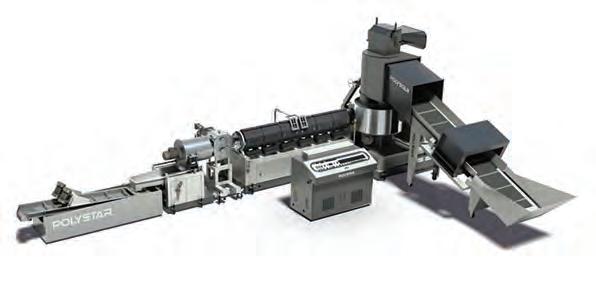
food waste in 2016–17.
We already have a number of initiatives to cut down on
waste to landfill, such as offering our residents and businesses discounted worm farms and compost bins.
As for commingled kerbside recycling, at the moment With its extreme accuracy, speed and consistency of cut, combined with very low operating costs, the new Yawei HLF fiber laser is the perfect way to take your business to the next level.
we are one of 30 councils looking for an alternate solution following the closure of SKM Recycling sites.
Kerbside recycling will be taken to a landfill facility until other arrangements can be made.
We are disappointed with this outcome and expect our residents will feel similarly.
We don’t want people to lose their good recycling habits while this is happening. In fact, we’d like people to increase their knowledge of what can be recycled and minimise contamination as much as possible. [comments Dollar for dollar, the new HLF is in a league of its own, opening up possibilities for companies all across the laser cutting sector; from start-ups through to full production, 3-shift environments. With a quality German built Precitec auto-focus cutting head, IPG laser source, Siemens 840DSL controller and a fabricated, stress-relieved fully annealed frame it really is a cut above Designed for reprocessing of polyethylene & polypropylene flexible packaging material Pelletising system with integrated cutter eliminates need for pre-cutting 100% of pellets reusable straight back into your production line Minimal material degradation without affecting material properties
published in early August]. Q. Where do you see waste and resource recovery heading? A. At present, the biggest challenge is the recycling sector. For more information: 03 9706 8066 sales@appliedmachinery.com.au www.appliedmachinery.com.au
In the future we would like to see a robust, local recycling industry that is supported by an increase in the amount of recycled product used in future infrastructure projects throughout Victoria. Connect with us socially
Fully compatible with FIMIC melt filters
appliedmachinery.com.au



